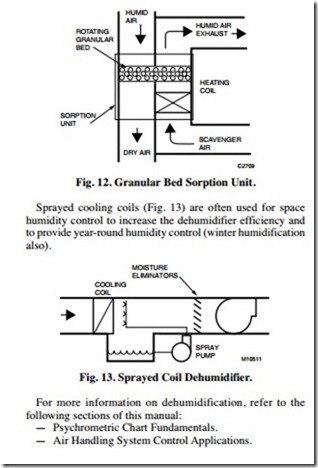DEHUMIDIFICATION
Air that is too humid can cause problems such as condensation and physical discomfort. Dehumidification methods circulate moist air through cooling coils or sorption units. Dehumidification is required only during the cooling season. In those applications, the cooling system can be designed to provide dehumidification as well as cooling.
For dehumidification, a cooling coil must have a capacity and surface temperature sufficient to cool the air below its dew point. Cooling the air condenses water, which is then collected and drained away. When humidity is critical and the cooling system is used for dehumidification, the dehumidified air may be reheated to maintain the desired space temperature.
When cooling coils cannot reduce moisture content sufficiently, sorption units are installed. A sorption unit uses either a rotating granular bed of silica gel, activated alumina or hygroscopic salts (Fig. 12), or a spray of lithium chloride brine or glycol solution. In both types, the sorbent material absorbs moisture from the air and then the saturated sorbent material passes through a separate section of the unit that applies heat to remove moisture. The sorbent material gives up moisture to a stream of “scavenger” air, which is then exhausted. Scavenger air is often exhaust air or could be outdoor air.
